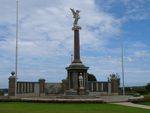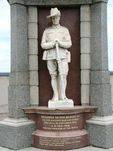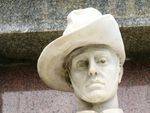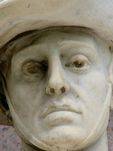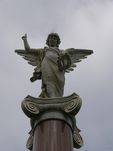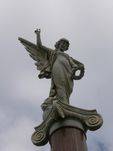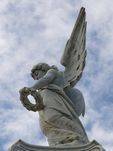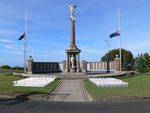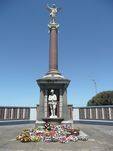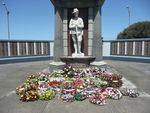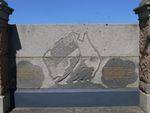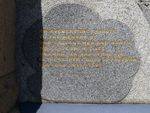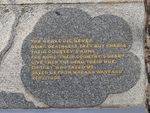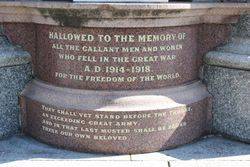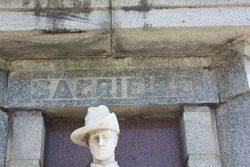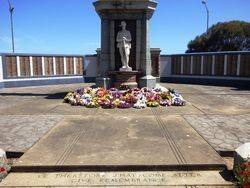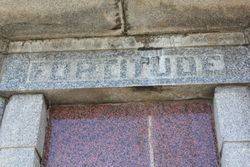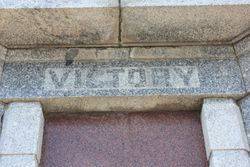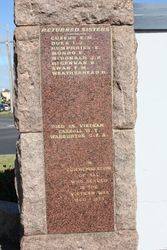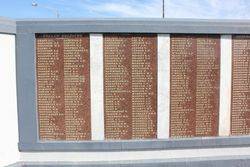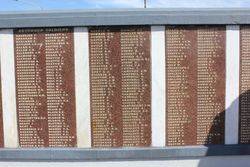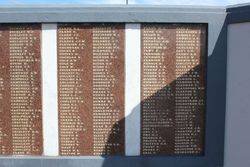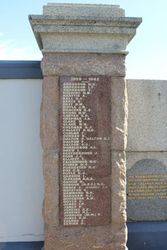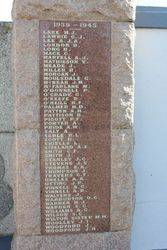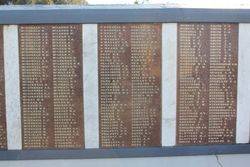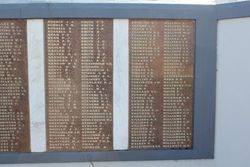
Soldiers` MemorialPrint Page 
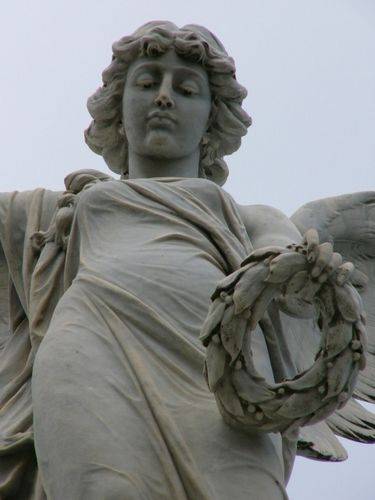
The Soldiers` Memorial was originally built to commemorate those from the District who served in World War One and was dedicated in memory of those who died in service or were killed in action.
It is a marble soldier statue on a three stepped plinth, with a granite column and an Angel of Peace at the top of the column which is approximately 12 meters high. A wall curves behind, engraved with the names of local people involved in the wars.
Warrnambool and district's memorial to the men and women who participated in the great war is now an accomplished fact. The important ceremony of unveiling the memorial was performed on Sunday. It was appropriate that ANZAC Day should have been chosen for the function, as the names on the monument included many of those who participated in the historic landing on Gallipoli. Unfortunately the weather was somewhat cold and rough for an outdoor function, but notwithstanding this drawback there was a large attendance of the public which was representative not only of the city, but also of the surrounding district. The Minister for Defence, Major-General Sir Neville Howse, who came in place of the Prime Minister to perform the official ceremony arrived by car from Hamilton and was escorted by a troop of the 4th Light Horse in charge of Lieut. Hughan, and was received by a Guard of the 21st Infantry Battalion, under Lieut. Simms. The distinguished visitor was greeted by the Mayor (Cr. Abbey) after which he inspected the Guard and took his place on the platform.
The service opened with the National Anthem, followed by the hymn. "O God, Our Help in Ages Past." The singing was led by a combined band under the leadership of Bandmaster Stainsby, and the choir of the Warrnambool Choral and Orchestral Society conducted by Mr E. Bright. Archdeacon Bennett led the assemblage in prayer, and the Rev. G. McLaren read the selected portion of Scripture. Then followed the hymn. "O Valiant Hearts Who to Your Glory Came." The Rev. G. McLaren led the gathering in prayer, and then Sir Neville Howse withdrew the Union Jack which had shrouded the figure of the soldier, at the same time expressing in appropriate terms the purpose for which the memorial had been erected and Archdeacon Bennett dedicated the memorial "to the glory of God and in memory of the men of this district who laid down their lives in the great war." At the conclusion of Sir Neville Howse's eloquent address, two verses of the Recessional were sung, followed by a moment's silence and the Last Post was sounded by Mr Geo. Davis. Prayer and the Benediction by Archdeacon Bennett concluded the service. Before dispersing, the Mayor presented Sir Neville Howse with a framed enlarged photo of the memorial and the Minister briefly acknowledged the gift. After the service, friends and relatives of fallen men placed a number of beautiful floral emblems on the memorial and many lingered about its base as though loath to leave the hallowed memories which it inspired.
The memorial is a beautiful piece of monumental masonry erected at a cost of about £3500. It stands 36 ft. high and consists of three Harcourt granite steps, polished Balmoral red and grey Harcourt granite pedestal with a segmental base on top of which stands the figure of a soldier in white marble 6 ft. high, with arms at the reverse. The expression of infinite sadness on the soldier's stern face is a fine example of the sculptor's art. The base of the pedestal bears the following inscription: "Hallowed to the memory of the gallant men and women who fell in the great war, 1914-1918, for the freedom of the world. Then shall they stand before the throne an exceeding great army, and in that last muster shall be found there our own beloved." The pedestal is surmounted by a Balmoral red granite column, marble capped with a beautiful figure of Peace 7ft. 9in. high on top.
On the four faces of the pedestal are the words "Sacrifice, Courage, Fortitude, Victory." At the back of the monument is erected four panel led Balmoral red and Harcourt granite posts. The two in front are surmounted by electric lamps, and the two at the entrance to Cannon Hill have polished granite globes on top and support the pair of specially designed memorial gates 8ft. high and 10ft. wide. Attached to these posts is an octagonal wing wall with polished Balmoral red granite panels and marble centre strips. On these panels is inscribed in gold letters the names of all those who enlisted from Warrnambool and district, numbering about 1,450, including 240 fallen men. The whole of the work, with the exception of the marble figures which were specially imported from Italy, was carried out here, and was erected in a skilled and workmanlike manner by the contractors, Messrs Wooles and Carpenter, Kepler street, Warrnambool.
Camperdown Chronicle (Vic.), 29 April 1926.
Location
| Address: | Merri & Leibig Streets, Cannon Hill, Warrnambool, 3280 |
|---|---|
| State: | VIC |
| Area: | AUS |
| GPS Coordinates: | Lat: -38.387306 Long: 142.481029 Note: GPS Coordinates are approximate. |
Details
| Monument Type: | Monument |
|---|---|
| Monument Theme: | Conflict |
| Sub-Theme: | Multiple |
| Monument Manufacturer: | Wooles & Carpenter |
Dedication
Hallowed to the memory of all the gallant men and women who fell in the Great War
A.D. 1914 - 1918
For the freedom of the world
They shall yet stand before the throne, an exceeding great army, and in that last muster shall be found these our own beloved



